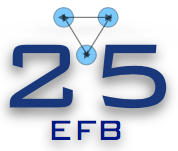Speaker
Description
Lattice quantum chromodynamics (LQCD) calculations of few nucleon systems started a new era of ab-initio predictions in nuclear physics. To obtain physical quantities, the finite-volume LQCD numerical results have to be extrapolated to free space. This extrapolation is traditionally performed using the Lüscher formula for the two-body case and its generalizations to larger systems. Recently, another method was introduced, where an effective field theory (EFT) is fitted directly to the finite-volume results and subsequently used to predict free-space results.
In this project, we aim to compare the two approaches. To mimic the LQCD results we use the nucleon-nucleon Minnesota potential solved in a box with periodic boundary conditions. The binding energies of systems of up to four nucleons are solved using the stochastic variational method (SVM). Fitting the next-to-leading order (NLO) pionless EFT to the finite-volume energies we use it to extract the free-space binding energies and scattering parameters. The same free-space quantities are also obtained through the Lüscher formula, and thus approaches can be compared on the same ground.

